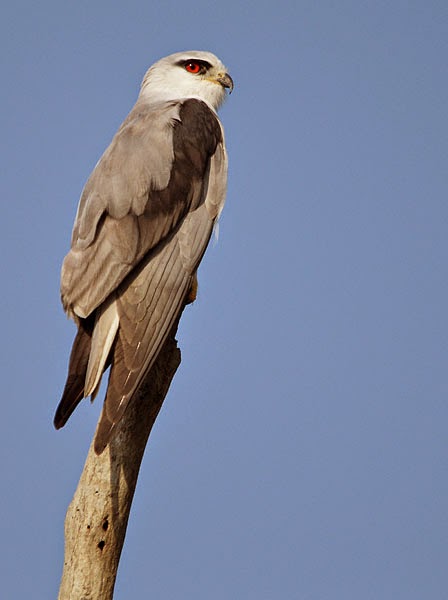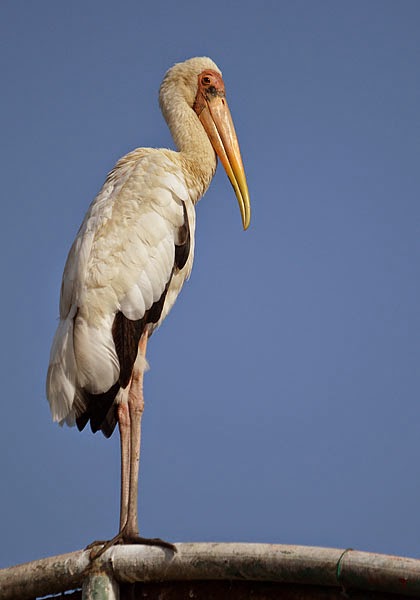Dave
and Hor Kee came back from a spontaneous weekday trip to the Kuala Gula Bird
Sanctuary in Perak with an adult male Rosy Starling record. I have only seen
this scarce migrant only once before and it was from this locality as well. But
back then, it was just a dull-looking juvenile bird and incomparable to the
beauty of the adult male that is worthy of a Shakespearean line. At the break
of dawn the following Saturday I found myself scanning the very area the
starling was last seen - naturally.
There
were plenty of the usual starlings and mynas but no signs of my target bird.
Despite a careful sweep, all I could find after an hour were more Jungle Mynas.
Where is Rosy, bud?
A
pair of Cinereous Tits foraged did come into view while I was waiting for the
Rosy Starling but the strong morning sun at their backs and the distance did
very little to cheer me up despite their adorable presence.
The
Pied Triller is common even in built-up areas but I do not have many good
photos of the striking male bird. So when a male happen to alight on the same
tree as the Tits, I gave him his due attention.
The
mangrove here is the stronghold of the Sunda Woodpecker. Like the Cinerous Tit,
it is also a mangrove specialist and is an absolute delight to observe it going
about its daily routine.
The
majestic White-bellied Sea-eagle is always a sight to behold despite being one
of the commonest eagles in Peninsula Malaysia
On
the contrary, this smaller Black-shouldered Kite that was also perched on a
dead tree next the access trail was not the least bothered by human presence.
Its confiding nature provided me with some good images and this kite is one of
the most elegant-looking raptors around.
During
the migratory season, it is not hard to see five different species of
kingfishers within the boundaries of this bird sanctuary. The Collared
Kingfisher is the commonest one at this coastal hotspot and this pair looks set
for the coming breeding season. Love is certainly in the air.
The
Common Kingfisher is not as common as its name implies. It is a winter visitor
to suitable watery habitats throughout Peninsula Malaysia
The
largest and loudest of them all is undoubtedly the Stork-billed Kingfisher.
With a bill like that, it is almost impossible to miss this stunning species whenever
it is around.
And
talking about loud, the breeding season will signal the beginning of the
persistent, almost to the point of being annoying, territorial calls of the
Asian Koel. Anyone in Peninsula Malaysia
This
exceptionally tame Striated Heron provided one of the highlights of the day.
Undoubtedly the commonest heron in Peninsula Malaysia
Because
of their abundance, this species is usually ignored by birders and I am also
guilty of this at times. But I find it hard to ignore any bird that is putting
on a performance like this…
Large
waterbirds are certainly one of my favourites and here, they are found in good
numbers. On this particular trip, there were quite a number of Grey Herons in
the vicinity.
The
number of juveniles present is a good indication that this species doing well
here indeed.
Kuala
Gula is the one of the last few places left on Earth where the globally
endangered Milky Storks still roam wild and free. The pure, wild birds are
usually found deep in their coastal domain and the best way to see them is by
boat. However, the Wildlife Department did some reintroduction programs years
back and these semi-wild storks can be seen quite regularly near the park
headquarters.
In
fact, they are so accustomed to humans that they are actually like to be near
human civilization. At times, they can
be as tame as domestic pigeons but they are still Milky Storks and some
admiration is inevitable.
One
last image to wrap up the trip and the honour goes to a confiding Garden Fence
Lizard that posed so willingly for me. By the way, I found out at the time of
writing that the Rosy Starling was seen again in the same area the day after my
visit. Welcome to the wonderful world of birding...






















5 comments:
yes Rosy is also always in my mind....
No Rosy Starling, but the "usual suspects" are adequate compensation.
I like the raised crest of the Striated Heron, too.
Yes, Mike. Ain't that the truth.
Thanks, John. It turned out quite good despite the miss.
I love the photos and the story. Too bad you missed the Rosy Starling. What you wrote about the calling Koels reminds me of the time that I was camping on the shores of a lake in Khaen Krachan NP in Thailand. I was the only one in the campground as dusk fell. I was sitting in a lawn chair surrounded by many Koels calling in the trees all around me. About the time they eventually fell silent, many frogs and toads took up the chorus. It was a noisy, but pleasant night.
Thanks, John. Yup, Koels certainly do leave a lasting impression.
Post a Comment